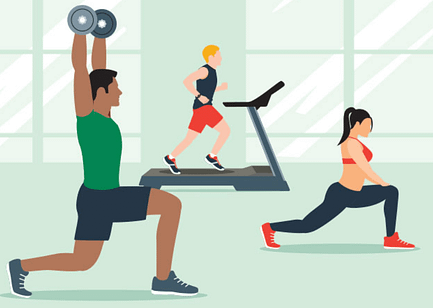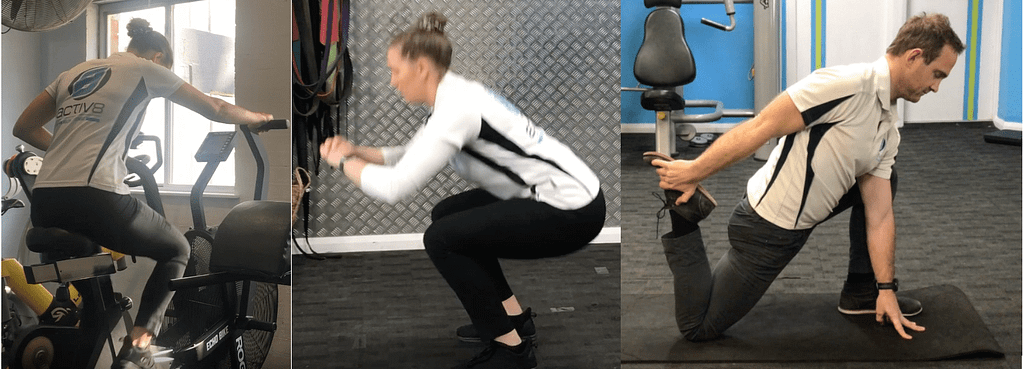
There is a lot of information and conflicting information as such out there regarding the current exercise recommendations. Furthermore, these keep changing over the years which makes it even harder to know. It also depends on many other factors including medical conditions (such as Cardiovascular Disease, Diabetes, Osteoporosis, Endometriosis, Chronic Pain) age level, gender and even the intensity of exercises undertaken throughout the week. In saying that, we have tried our best to give you the latest information (Current to 2023) regarding the most common situations in the simplest digestible (get it…?) form.
Within the apparently healthy population (a state of complete physical, mental and social well-being and not merely the absence of disease and infirmity as stated by WHO), individuals are unsure if they’re hitting the recommended amount of weekly exercise minutes. Due to this, a greater case in the development of lifelong conditions such as diabetes and heart disease has occurred, leading to a rise in global levels of sickness and death.
Needless to say, exercise is an amazing way to help prevent, manage or delay the onset of these prevalent conditions, along with so many more benefits, but you may be thinking, what exactly should you be doing, and how many minutes you should be aiming for? Well, this blog will uncover all the information you need to know!
Physical inactivity is a term that is not uncommonly used, particularly among Australians. Due to the natural demands of life such as work, children/family commitments and hobbies, along with other aspects such as injury, individuals may struggle to have the time, motivation or desire to partake in exercise, which is completely understandable! In saying this, it is thought that nearly 60% of Australian adults, and 70% of pregnant women do not meet the recommended weekly exercise minutes resulting in an increased likelihood of developing lifelong chronic conditions.
Enough about the negative side of things though, as you may be thinking what the benefits of being physically active are. Well, similarly to the negative impacts of physical inactivity, exercise has flow-like effects too! Being physically active has the overarching stem of reducing the likelihood of developing chronic conditions as mentioned, but there is much more to delve into.
Exercise holds numerous benefits both physically, mentally and even socially! Starting with the mental benefits, exercise is a prime way to release our happy hormones called endorphins. The release of these happy chemicals helps reduce levels of stress and increase feelings of well-being, which in tandem helps reduce levels of depression and anxiety. Furthermore, the physical benefits of exercise come in abundance, primarily reducing the risk of obesity, which reduces or maintains blood pressure, total cholesterol and blood sugar levels. Further improvement in quality of life, sleep quality and energy levels also occur. This then can be linked to the overarching stem of reducing the likelihood of developing chronic conditions!
There are three (3) main modalities of exercise, them being cardiovascular, resistance, and flexibility. Each of these modalities holds various and numerous benefits, but are a fantastic mixture when used in tandem with each other!

As mentioned, the ideal minutes are different between populations, so depicted in the table below are three subgroups associated with the apparently healthy population.

2. Pregnant Women

3. Individuals with Lower Back Pain

In summary, it’s important to acknowledge that any amount of exercise, no matter how brief, is a step in the right direction toward a healthier lifestyle. However, when we delve deeper into the realm of fitness and well-being, we find that the most significant rewards, both for our physical and mental health, emerge when we commit to a more structured exercise routine.
The magic number to aim for is approximately 150 minutes of weekly cardiovascular exercise, ideally supplemented with resistance and flexibility training. This balance strikes a harmonious chord in our pursuit of overall wellness. Why, you ask?
First and foremost, cardiovascular exercise elevates our heart rate, strengthens our lungs, and enhances circulation, effectively boosting our cardiovascular health. This form of exercise, which includes activities like brisk walking, running, cycling, and swimming, plays a pivotal role in reducing the risk of heart disease, stroke, and hypertension.
On the other hand, resistance training, such as weightlifting or bodyweight exercises, empowers our muscles and bones. This crucial component of the ideal workout routine not only helps sculpt a toned physique but also fortifies our skeletal system. By engaging in resistance training at least a couple of times a week, we can actively combat the decline in muscle mass associated with aging and promote better metabolic health.
Flexibility training, often encompassed by practices like yoga or stretching exercises, enhances our range of motion and helps prevent injuries. It keeps our joints supple and muscles pliable, reducing the risk of strains, sprains, and other physical mishaps.
But perhaps the most compelling reason to strive for this comprehensive exercise regimen is its role in disease, illness, and injury prevention, management, and delay. Regular exercise, when combined with a balanced diet and other healthy lifestyle choices, can be a formidable ally against chronic diseases like diabetes, obesity, and certain types of cancer. It helps manage conditions such as arthritis and osteoporosis, improving overall quality of life. Moreover, it aids in the prevention of injuries by enhancing our physical resilience and reducing the risk of accidents.
In essence, while any minute of exercise is undoubtedly better than none, it’s the dedication to a well-rounded exercise routine that truly unlocks the extensive benefits for our body and mind. It’s a commitment to your health, longevity, and vitality. So, as you embark on your fitness journey, remember that striving for approximately 150 minutes of weekly cardiovascular exercise, complemented by resistance and flexibility training, is a powerful formula that can lead to a healthier, happier you, while simultaneously delaying, managing, or preventing a host of diseases, illnesses, and injuries.
Written by Accredited Exercise Physiologist Paolo Mitry from Activ8 Health Club